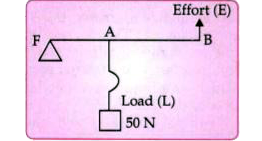Define mechanical advantage of a lever.
Step-by-Step Solution
1. Understanding the Concept of a Lever:
A lever is a simple machine that consists of a rigid bar that can rotate around a fixed point called the fulcrum. It is used to lift or move loads with less effort.
2. Identifying Components of a Lever:
In a lever system, there are three main components:
- Load (F2): The weight or resistance that needs to be moved.
- Effort (F1): The force applied to lift the load.
- Fulcrum: The pivot point around which the lever rotates.
3. Defining Mechanical Advantage:
The mechanical advantage (MA) of a lever is defined as the ratio of the load (output force) to the effort (input force). It can be mathematically expressed as:
Mechanical Advantage (MA)=Load (F2)Effort (F1)
4. Interpreting Mechanical Advantage:
A higher mechanical advantage means that a smaller effort is required to lift a larger load. This is a key benefit of using levers, as it allows for the lifting of heavy objects with less force.
5. Conclusion:
In summary, the mechanical advantage of a lever is a measure of how effectively the lever can amplify the input force to lift a load. It is crucial in understanding how levers work in various applications.
A lever is a simple machine that consists of a rigid bar that can rotate around a fixed point called the fulcrum. It is used to lift or move loads with less effort.
In a lever system, there are three main components:
- Load (F2): The weight or resistance that needs to be moved.
- Effort (F1): The force applied to lift the load.
- Fulcrum: The pivot point around which the lever rotates.
The mechanical advantage (MA) of a lever is defined as the ratio of the load (output force) to the effort (input force). It can be mathematically expressed as:
Mechanical Advantage (MA)=Load (F2)Effort (F1)
A higher mechanical advantage means that a smaller effort is required to lift a larger load. This is a key benefit of using levers, as it allows for the lifting of heavy objects with less force.
In summary, the mechanical advantage of a lever is a measure of how effectively the lever can amplify the input force to lift a load. It is crucial in understanding how levers work in various applications.
Topper's Solved these Questions
- SYSTEM OF PARTICLES AND ROTATIONAL MOTIONBOOK - AAKASH INSTITUTE ENGLISHCHAPTER - SYSTEM OF PARTICLES AND ROTATIONAL MOTIONEXERCISE - Assignment (Section - J) Aakash Challengers Questions
13 Videos
- SEMICONDUCTOR ELECTRONICS: MATERIALS, DEVICES AND SIMPLE CIRCUITSBOOK - AAKASH INSTITUTE ENGLISHCHAPTER - SEMICONDUCTOR ELECTRONICS: MATERIALS, DEVICES AND SIMPLE CIRCUITSEXERCISE - Assignment (Section-D (Assertion and reason))
5 Videos
- TEST 1BOOK - AAKASH INSTITUTE ENGLISHCHAPTER - TEST 1EXERCISE - EXERCISE
21 Videos
Similar Questions
Write down a relation expressing the mechanical advantage of a lever.
View SolutionCalculate the ideal mechanical advantage of a lever in which the effort arm is 60 cm and the load arm is 4 cm.
View SolutionIf the mechanical advantage of a lever is 2.5, what will be the effort you need to apply to lift a load of 50 N?
View SolutionThe diagram below shows a lever in use.

If FA = 40 cm, AB = 60 cm, then find the mechanical advantage of the lever.
View SolutionIf the parallel forces acting on a lever are in the ratio 3:5 then what is the mechanical advantage of the lever ?
View SolutionThe diagram alongside shows a lever in use :
Without changing the dimensions of the lever, if the load is shifted towards the fulcrum what happens to the mechanical advantage of the lever ?

View SolutionThe diagram below shows a lever in use :

Without changing the dimensions of the lever, if the load is shifted towards the fulcrum what happens to the mechanical advantage of the lever ?
View SolutionFigure below shows a lever in use

(a) To which class of levers does it belongs ?
(b) Without changing the dimensions of the lever, if the load is shifted towards the fulcrum what happens to the mechanical advantage of the lever ?
View SolutionIf the Mechanical Advantage of a lever of 100, when a force of 10N acts as a distance of 20cm from the point of fulcrum. Calculate the force acting on the other side of the fulcrum and the distance of that force from the fulcrum.
View SolutionThe diagram below shows a lever in use.

(a) To which class of lever does it belong ? Give one example of this class.
(b) How will the mechanical advantage of lever change if load is shifted towards the fulcrum without changing it's dimensions.
View Solution
